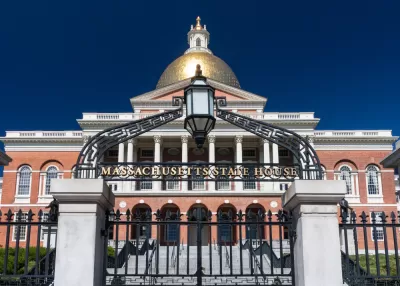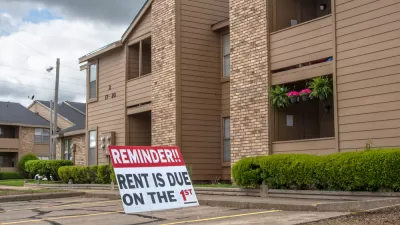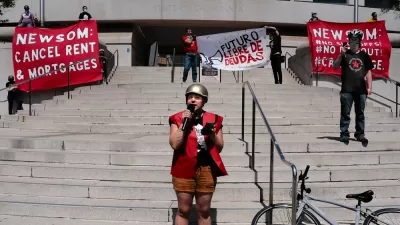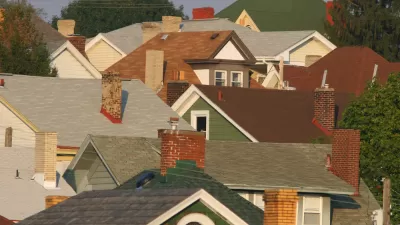The Massachusetts eviction moratorium—one of the strongest in the nation—expired, just in time for winter. How did this happen?

Lynn Shore Drive, one of the most well-trafficked oceanside roadways on Massachusetts’ North Shore, is also a land bridge between two worlds. Starting in Lynn, a working-class community with a large Latinx population—and some of the highest COVID-19 infection numbers in the state—the Shore Drive curves northeast toward the tony enclave of Swampscott. Here, Queen Anne Victorian houses sell for upward of $2 million. Gov. Charlie Baker lives here, near the center of town. And on a brisk October evening, as the sun paints the seascape with a pinkish glow, people are marching up the Shore Drive, heading straight toward Baker’s house.
Community organizers, tenants, small landlords, and a crowd of multigenerational locals have converged to stage a protest outside Baker’s residence. Some of them are beating drums, as passing drivers toot their horns. Others carry banners, flags, and bullhorns. But the most telling thing here is the black cardboard coffins that several marchers are carrying. Each coffin is emblazoned with words printed in white, in both English and Spanish. The first coffin pretty much says it all:
“Evictions = Death.”
Back in March, when Northeastern cities and metro areas like Greater Boston were crippled by the first wave of COVID-19, a couple of Massachusetts state representatives worked with local housing activists to create an eviction (and foreclosure) moratorium that Gov. Baker would sign in April. It was one of the most far-reaching moratoriums in the nation, delaying all court-based eviction proceedings; protecting tenants from late fees, negative credit reporting, and physical evictions; and extending protections to those at risk of foreclosure. As thousands of Massachusetts residents contracted and died from COVID-19, the state eviction moratorium allowed people to at least stay in their homes.
But the Massachusetts moratorium was never a long-term solution for the housing crisis posed by the COVID-19 pandemic. Tenants were left to accrue back rent debt. Small landlords risked falling behind on mortgage payments. Noting these sustainability problems at a press conference in September, Gov. Baker said, “The longer this thing goes on, the deeper the hole gets, not just for tenants, but also for landlords, especially small landlords who have in many cases run out of rope.” The implication was clear.
Baker let the moratorium lapse on its Oct. 17 expiration date.
The creators of the Massachusetts moratorium had planned for this. Joining forces with the same activist groups that shaped the eviction freeze, Reps. Mike Connolly and Kevin Honan spent early summer working on a legislative sequel. H.4878, aka the Housing Stability Act, would not only extend the moratorium to December 2021, but would include more economic support for small landlords and tenants. And yet, unlike the eviction ban, the Housing Stability Act wasn’t given a floor vote after being presented. Instead, it became stuck in committee for months, ignored by the Democratic house speaker, Robert DeLeo. Despite a groundswell of organizing from Massachusetts residents, the bill was not taken up by the legislature, and on Oct. 17, the Massachusetts eviction moratorium expired, just in time for winter, when coronaviruses spread more readily.
How did this happen?
The Act
If nothing else, Massachusetts’ initial eviction moratorium was a success story of what’s possible when the energies and perspectives of grassroots community organizers and state politicians merge organically, yielding policy. In March, just after the World Health Organization declared the pandemic ...
FULL STORY: Massachusetts Showed States How to Create an Eviction Ban. Now It’s Backpedaling

Alabama: Trump Terminates Settlements for Black Communities Harmed By Raw Sewage
Trump deemed the landmark civil rights agreement “illegal DEI and environmental justice policy.”

Planetizen Federal Action Tracker
A weekly monitor of how Trump’s orders and actions are impacting planners and planning in America.

The 120 Year Old Tiny Home Villages That Sheltered San Francisco’s Earthquake Refugees
More than a century ago, San Francisco mobilized to house thousands of residents displaced by the 1906 earthquake. Could their strategy offer a model for the present?

San Francisco Opens Park on Former Great Highway
The Sunset Dunes park’s grand opening attracted both fans and detractors.

Oregon Legislature to Consider Transit Funding Laws
One proposal would increase the state’s payroll tax by .08% to fund transit agencies and expand service.

Housing Vouchers as a Key Piece of Houston’s Housing Strategy
The Houston Housing Authority supports 19,000 households through the housing voucher program.
Urban Design for Planners 1: Software Tools
This six-course series explores essential urban design concepts using open source software and equips planners with the tools they need to participate fully in the urban design process.
Planning for Universal Design
Learn the tools for implementing Universal Design in planning regulations.
Clanton & Associates, Inc.
Jessamine County Fiscal Court
Institute for Housing and Urban Development Studies (IHS)
City of Grandview
Harvard GSD Executive Education
Toledo-Lucas County Plan Commissions
Salt Lake City
NYU Wagner Graduate School of Public Service





























